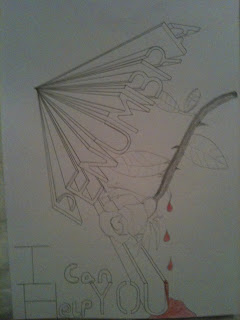During production, I have been taking some photos to create a portfolio of the production process and these are just a small minority of the pictures taken which are a preview of how myself and Blaine work on set and how we go from ideas to film.
 This is a make shift dolly that I spontaneously thought of one evening, I combined the wheels of this small trolly with some toy car track to make the ride smooth and the shot smooth when we wanted a pan shot of the protagonist in the final scene.
This is a make shift dolly that I spontaneously thought of one evening, I combined the wheels of this small trolly with some toy car track to make the ride smooth and the shot smooth when we wanted a pan shot of the protagonist in the final scene. In the end the dolly didn't work on the track because it kept coming off, but we tried it without the track and it worked well. As it was raining i had brought many umbrellas and we were shooting under one of them because we really needed to capture the last scene. We got some very good shots but we are going to have to re-shoot because the lighting changed very quickly which made many shots impossible to film.
In the end the dolly didn't work on the track because it kept coming off, but we tried it without the track and it worked well. As it was raining i had brought many umbrellas and we were shooting under one of them because we really needed to capture the last scene. We got some very good shots but we are going to have to re-shoot because the lighting changed very quickly which made many shots impossible to film. This is just an action shot of Blaine filming the classroom scene, it shows SLR camera that we are using. (Got you Blaine) (It also makes it look like your wearing nail varnish)
This is just an action shot of Blaine filming the classroom scene, it shows SLR camera that we are using. (Got you Blaine) (It also makes it look like your wearing nail varnish) This is Blaine explaining the scene to the actors and extras in the classroom, he is explaining the shots we are using and then we had a run-through of the script.
This is Blaine explaining the scene to the actors and extras in the classroom, he is explaining the shots we are using and then we had a run-through of the script.  This is a picture to give a sense of the scene, but it also act as a continuity image because whilst filming they had to leave and enter the room many times to acquire many different shots and in order to have great continuity I had to record we everyone was sitting.
This is a picture to give a sense of the scene, but it also act as a continuity image because whilst filming they had to leave and enter the room many times to acquire many different shots and in order to have great continuity I had to record we everyone was sitting. Finally this is just a picture of the shot list that Blaine create after we had a brainstorm of ideas for each scene. This was an efficient way to record the shots that we had captured and needed to film but whilst we were getting these shot both myself and Blaine were coming up with new shots which we thought would look good at the time and we got many extra shots on each scene that we were filming.
Finally this is just a picture of the shot list that Blaine create after we had a brainstorm of ideas for each scene. This was an efficient way to record the shots that we had captured and needed to film but whilst we were getting these shot both myself and Blaine were coming up with new shots which we thought would look good at the time and we got many extra shots on each scene that we were filming.If you want to view Blaine's post on-set organization it shows all of the different shot lists that we used and how we organized each day of filming.













